Can You Put Clear Epoxy Over Htv Vinyl
Larn how to safely utilise epoxy resin on your custom tumblers and minimize exposure! I explain epoxy safety and the exact steps you need to have to avoid toxic exposure and allergic reactions. Epoxy doesn't accept to be scary if you use it safely!
About a twelvemonth ago I made some fun glitter tumblers, coated them with epoxy resin, and showed you how to do it with a detailed footstep-by-step tutorial and video. Epoxy resin is pop for tumblers considering it creates a beautiful, glass-similar coating that protects everything inside it, like your paint, glitter, and decals. Merely it's important to handle epoxy safely to avoid exposure and potential allergic reactions. And so with epoxy resin's rise in popularity, I want to go into more depth on epoxy safety, because y'all Can utilize epoxy for your tumblers safely if you follow just a few important steps.
Sentry my full video demonstrating all of my epoxy condom techniques!
Offset, it's really of import to read and follow the safety information sheet (SDS) that comes with your epoxy resin. Ever know what safety measures any manufacturer recommends for its products, whether it's for epoxy, paint, glitter, sealer, or really anything else you craft with. You can find prophylactic data sheets in the product box, but if they are missing, merely go online and search for the production name + "safety data sail." Hither is the rubber information sheet for Alumilite Clear Cast, which is the epoxy resin I use and recommend. Their safety data sheet tells united states of america that epoxy "causes severe skin irritation and heart impairment. Harmful if swallowed. Avoid contact with the skin, eyes, and clothing. Wear advisable protective gloves, protective spectacles. Launder hands well after handling. Avoid discharge into the surround." Let's really talk about what that means!
So epoxy resin comes in two bottles—an A side and a B side. The A side is the actual epoxy resin, and the B side is a curing agent. Epoxy in its liquid, uncured country is mostly classed as irritant to the eyes and pare, which is what you'll meet in the safety information sheets. It'south the mixing and curing process that we need to be nigh conscientious with, because that'south when they are most harmful to us. And to get that pretty glass-like coating on our tumblers, we have to measure out an equal portion of both A side and B side and mix them together carefully ourselves. But once fully cured, epoxy is considered safe and is classified as a non-hazardous material.
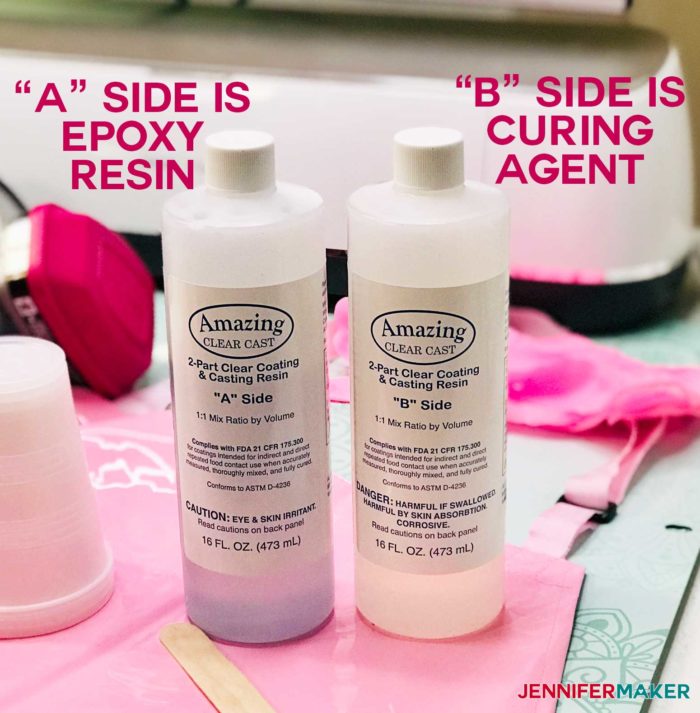
Okay, then how do y'all mix and cure epoxy on your tumblers safely? Here are the three important things to recall:
- Wear proper personal protective equipment
- Piece of work in a ventilated surface area
- Go along your craft expanse clean

Let'south talk about each of these epoxy condom precautions in more item. This post contains some affiliate links for your convenience (which means if you make a buy afterwards clicking a link I will earn a small commission but it won't cost you lot a penny more)! Read my total disclosure policy.
Wear Proper Personal Protective Equipment for Epoxy Safety with Tumblers
When I work with epoxy, I protect myself from touching or inhaling epoxy by wearing proper personal protective equipment, which some simply telephone call PPE. That ways gloves, a respirator, and an frock over a long-sleeve shirt.
Gloves (Nitrile, PVC, Neoprene – Not Latex)
Wear gloves every time you mix, castor, pour, or clean epoxy—basically every time there's a possibility your skin could come into contact with uncured epoxy. Repeated skin exposure to epoxy can lead some people to develop a permanent allergy to it. I recommend and wear nitrile gloves because they offer better resistance to epoxy and solvents. Nitrile gloves are inexpensive, piece of cake to come by, come up in different sizes for a good fit, and you can become them in beautiful colors. Do non use latex gloves, equally they are too porous and can nifty when in contact with solvents. If yous are sensitive or allergic to nitrile, opt for PVC (vinyl) or neoprene gloves instead.

IMPORTANT: If you do go epoxy on your skin, launder it immediately with regular soap and h2o twice. Do not wipe information technology away with booze, acetone, or whatsoever solvent equally this can cause your skin to absorb the epoxy easier, which we do not want.
Respirator (Full Face, or One-half-Face up with Goggles)
Habiliment a respirator with organic vapor filter cartridges every time you are near uncured epoxy. The fumes are hazardous to us, our children, and our pets. A respirator with organic vapor cartridges (the magenta ones) volition protect you. I recommend a full-face respirator considering of the dangers of irritating your eyes, likewise. If yous don't have a full-face respirator, you can utilize a half-face one with goggles. But if you are at all sensitive or allergic to epoxy, you'll want a expert-fitting total-face respirator that forms a tight seal. Also notation that the organic vapor cartridges brainstorm working every bit soon as you expose them to air. To go on your cartridges working every bit long as possible, store your respirator in an airtight container between uses. The organic vapor cartridges must exist replaced every six months at a minimum. If you can always smell the epoxy with the respirator on, it'south time to change those cartridges!
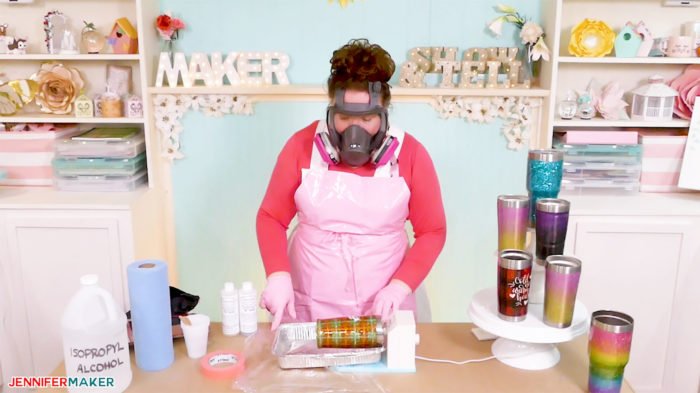
Here'southward a selfie of me in my respirator — would love to encounter YOU in your respirator, too!
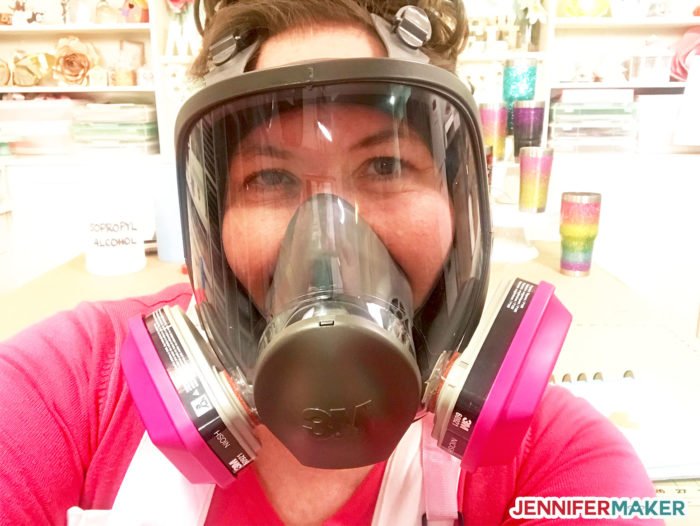
Apron/Accommodate (PVC or Tyvek)
Spills and drips happen, and if you get epoxy on your clothing, information technology'due south easy for information technology to come in contact with your peel. It'south also pretty much impossible to get epoxy out of clothing. So I wear a PVC apron when I'm working with epoxy. I also wear long sleeves to avoid peel contact with the epoxy. And if you already know that you're sensitive or allergic to epoxy, or desire maximum exposure protection, consider wearing a Tyvek suit.
Hither are links to the aforementioned proper protective equipment I apply when I work with epoxy resin:
- Dispensable nitrile gloves
- Respirator with organic vapor cartridges (the pink magenta ones)
- PVC frock and long sleeves (if y'all already know that yous're sensitive or allergic to epoxy, or want maximum exposure protection, consider wearing a Tyvek suit)
Don't forget an airtight box or respirator storage handbag to keep your respirator in when you're non using information technology.
Work in a Ventilated Area to Avoid Exposure to Fumes
Epoxy fumes generated while mixing and curing are toxic, and you must work in a well ventilated expanse for your safety. Fumes are produced for the unabridged time the tumblers are curing (so similar 72 hours). If possible, work outside in the fresh air. If that'due south not possible, you need to accept some extra steps. The worst matter you can do is work in a closed room with poor ventilation, which describes virtually people's craft rooms. At minimum, y'all'll want to open a window and turn on a strong fan to vent the fumes outside. If necessary, buy a fan and position it and so it draws air away from you lot.
Note: If you're working outside, be aware that the temperature must be at least lxx°F for for mixing and pouring epoxy, and ideally 75-85° F for curing. Whatsoever colder and your epoxy will not cure.
If you already know that you're sensitive or allergic to epoxy, or want maximum exposure protection, consider buying or making an epoxy smoke booth. You can brand one inexpensively using an indoor grow tent large enough to stand in (so at least 4'x 4′ x 72″), an inline duct fan strong enough to properly substitution the air in your grow tent at to the lowest degree in one case every infinitesimal (and so employ a fan at least 110 CFM in a iv'x4′ tent), and enough aluminum dry vent hose to carry the fumes exterior. The exhaust vent needs a dryer-type vent hose to reach a window—you can use a window unit of measurement mounting kit to seal the window effectually the vent, or simply cutting a slice of insulation foam to fit the window opening and run the fan/vent out of it. Information technology's important that the fumes are actively removed from your tent — y'all cannot just use the tent or all yous're doing is trapping the fumes in in that location. Exist certain to wear your proper personal protective equipment whenever you enter your epoxy tent, as the fumes volition be much more than full-bodied in such a small infinite.
Tip: You can use this Fan CFM Estimator to make up one's mind the strength of your inline duct fan (your "frequency of desired air" should be ane).
Because we work with things like epoxy and spray paint often, we created our ain inexpensive fume booth (which we use both for epoxy and spray paint fumes) with the following equipment:
- four′ x viii′ x 78″ Grow Tent
- Inline Duct Fan (390 CFM)
- Aluminum dryer vent hose (25 feet)
- Insulation Foam
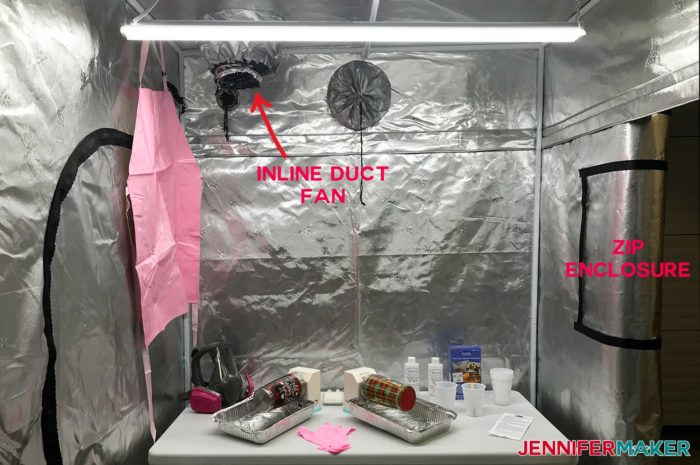
Note: I like to use moisture/dry sandpaper to wet sand my epoxy tumblers because I feel it's safer (it doesn't put a lot of epoxy dust in the air that tin then be inhaled). If you also do this, make certain you keep the surface area you work in well ventilated, article of clothing your gloves and respirator, and wash any exposed skin carefully later on sanding.
Keep Your Area Clean for Epoxy Safety
Information technology's important that yous protect your work surface from epoxy spills and drips. It's a good idea to use a disposable plastic canvas over any surface you need to protect. Tape like electrical tape tin can exist used to keep the plastic in place—it's too great for protective your tumbler rims and bottoms, or any other thing you don't want epoxy to get on. I also recommend disposable cups and popsicle sticks for mixing, and paper towels for wiping upwards things, as this volition mean you can dispose of them right away. It also helps a lot of proceed your work area make clean and uncluttered, as this volition avoid accidents.
Yous'll also want to have 91% isopropyl booze on mitt for wiping up the rims of tumblers and any spills you accept. Some people likewise use acetone, but I don't often employ it because it'south and so strong and it's typically non necessary. Just don't use either alcohol or acetone on your skin if you get epoxy on it.
And it's equally important to pay attention to your epoxy clean-up process. Keep a trash can or pocketbook near you lot as you work so you tin put these items in in that location immediately, and then remove it correct away from your work area when you lot are done. Information technology'southward important to annotation that containers of uncured epoxy resin should not be thrown away—they can create heat which could atomic number 82 to a fire hazard in a pocket-size enclosed identify like a trash bag. If you have a fleck of epoxy leftover, permit information technology to cure next to your tumblers as they cure and then dispose of it.
Is Epoxy Resin Food Safe?
I think it's also important to talk about epoxy and food safety. If you're making tumblers, y'all need to be sure that the epoxy resin you're using is food condom after information technology'southward cured and becomes an inert plastic. There'due south a lot of unlike epoxies out at that place and not all are food safe. Even "nutrient rubber" is a bit misleading, because in the case of epoxy, "food safe" but means that you tin can put it on the outside of food and drink containers — never inside. E'er check the data that comes from the manufacturer to ensure information technology is condom to utilize on something similar tumblers.
I used Alumilite Astonishing Clear Blanket & Casting Resin, which is considered "nutrient prophylactic" later on curing when applied to the OUTSIDE of a food or beverage container. However, it'south important to note that food safe does non hateful it's okay to always consume or drinkable directly from an epoxied surface. That'south one of the reasons why when I make tumblers, I usually terminate my resin about iii/4″ from the rim—this means the resin never touches the drinker's lips. I only feel this is better. If your tumbler comes with a straw and your lip isn't touching the rim, experience free to bring that up to the top—but don't get over the top and into the tumbler.
Are There Any Alternatives to Epoxy if You Want to Make Tumblers?
Yeah, I currently know of these alternatives to epoxy resin if you are sensitive, allergic, or cautious just all the same want to make custom tumblers.
- Crystalac (a water-based polyeurethane)
- Clear Diamond Stop (a clear urethane)
- 2K Clear Glamour Clear Glaze (a spray urethane)
I have not tried these myself yet, then I cannot comment on their effectiveness, prophylactic, or look & feel — I simply know that some tumbler makers like to use these products and I plan to experiment with them myself in the future.
Get my free epoxy safety sheets to print out and keep handy!
To help you stay safe, I've created some epoxy safety sheets (File #164) that you tin print out and proceed for future reference. Keep a copy with your tumbler supplies so you lot think to stay rubber!
If you make something with epoxy, please share a photo in our Amazing Cricut Facebook group, email information technology to me at [electronic mail protected], or tag me on social media with #makershowandtell. I'd also love to come across photos of you wearing your proper personal protective equipment!!
Love,

Want to remember this? Salve the Epoxy Rubber for Tumbler Making Guide to Your Favorite DIY Pinterest Board!
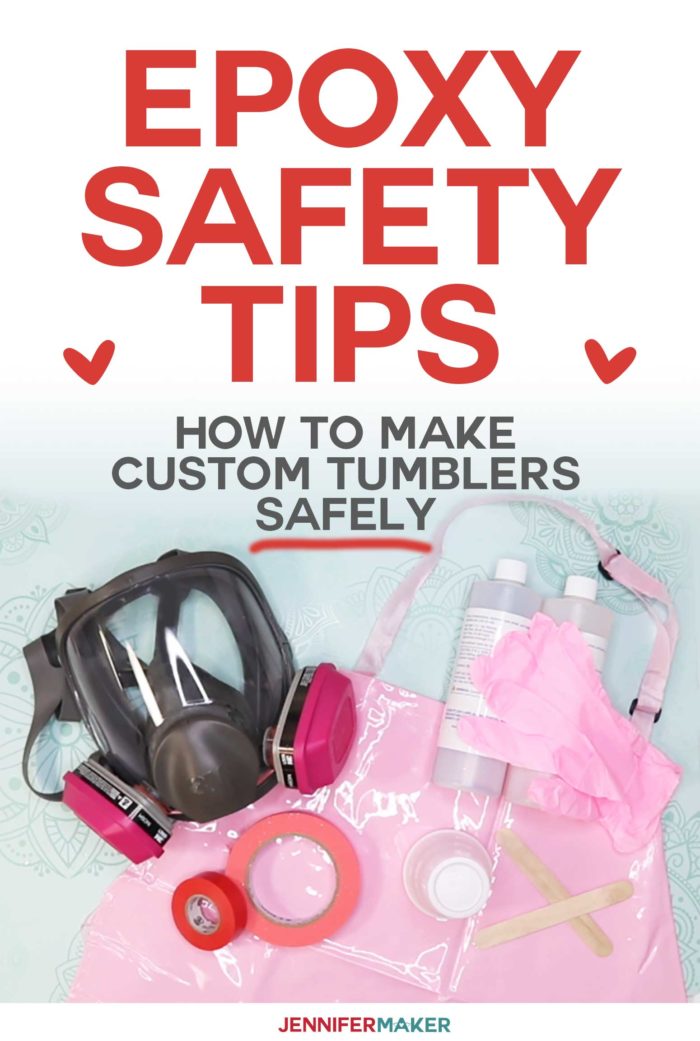
Source: https://jennifermaker.com/epoxy-safety-make-tumblers-safely/
Posted by: sherwoodimence.blogspot.com


0 Response to "Can You Put Clear Epoxy Over Htv Vinyl"
Post a Comment